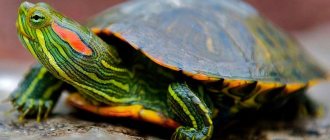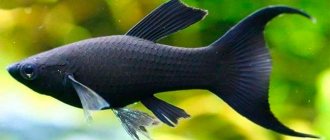One of the unusual aquarium pets is crayfish. It is brightly colored and does not require special skills or knowledge in maintenance. Crayfish in an aquarium do not mix well with other inhabitants. It is not recommended to keep them in a common tank, as this can adversely affect the health of the fish. The exception is dwarf species of arthropods. It is worth considering that there are about 100 types of crustaceans on earth. Some species were bred artificially in the aquarium industry. Each of them requires special conditions of detention.
Keeping aquarium crayfish
If you create comfortable conditions, caring for crayfish in an aquarium does not cause any difficulties. We are talking about dwarf species that get along without problems with many types of fish. It is better to keep crayfish in separate tanks.
Common arthropods are accustomed to their natural habitat, which contains soil. For crayfish of this species, conditions should be created in which the presence of plants and a sandy bottom will be mandatory.
The volume of the tank must be more than 70 liters. The presence of filtering devices and water aeration is necessary.
Soil is an integral element of the tank when keeping aquarium crayfish. Its height should not be less than 6 centimeters. They lead a cautious lifestyle and spend most of their time hidden. They often dig minks and caves, so the soil component should be soft and comfortable. River pebbles, pieces of red brick or artificial filler are suitable as such materials. If this is not the case, then you can use pre-soaked expanded clay.
Ornamental crayfish build their shelters near driftwood and plants. The burrow is located directly next to the rhizome, as it prevents the destruction of the structure. Thickets are a favorite place for crayfish, so their presence in the tank is a necessary condition. Replacing the soil with decorative ceramic shelters will not prevent burrowing. It can only serve as good protection, especially for dwarf swamp crayfish.
Cancer in the aquarium
Plants maintain the necessary balance in the aquarium and are an important part of the ecosystem. Algae must have powerful roots and large leaves. Aponogetones and cryptocorynes are well suited for this. You should take care of the plants, as digging holes can damage the root of the algae.
Depending on the volume of the aquarium, the water filtration activity is calculated. Bacterial outbreaks often occur in crayfish tanks. This is due to the fact that food particles hidden by creatures in burrows begin to gradually decompose. Biological filters do not cope with their task. As a result, the water becomes cloudy and begins to smell unpleasant. In such cases, a filter device must be installed. Neglecting this factor will lead to illness of crustaceans and other creatures of the decorative pool.
If the level of microbes increases, the water in the tank must be changed. Liquid taken from another container with fish is good for this. It will help restore biobalance. The water in which crayfish live needs to be changed once a month. Thanks to this, the amount of harmful toxins and nitrates in the tank is reduced, and oxygen increases, which has a beneficial effect on the growth of algae.
A prerequisite is compliance with the hydrochemical parameters of the water. Crustaceans are unpretentious creatures, but conditions should be created that will be as close as possible to their natural habitat.
The water temperature should be between 20–26 degrees. The acidity level must be maintained at 5–8 pH. Hardness does not play a special role, but very soft water has a negative effect on the body of crayfish, especially during periods of molting.
The level of illumination does not have a significant impact on the condition of crustaceans, since they are nocturnal.
How long do crayfish live at home?
The lifespan of crustaceans is influenced by many factors. The main thing is the purity of the water. Crayfish can live up to 25 years. Wastewater has a negative effect on the body and rapidly shortens the life of the animal.
Crayfish do not live as long in captivity as in their natural habitat. This is due to the hydrochemical composition of water. It can be difficult to find one. With the right ratio of temperature and hardness, crayfish can live in tanks for 2–5 years.
Shedding
Molting is common for crayfish. Throughout their life, arthropods grow. The chitinous cover does not allow this to be done, as it is rigid. In this regard, cancer needs to be reset regularly.
During molting, the arthropod loses its activity and spends most of its time in shelter. If instead of a pet, only its shell was noticed, do not be alarmed, this is a natural process of the crustacean body. It is not worth removing the old chitinous cover, as it will be consumed by arthropods. After molting, young crayfish need a large amount of calcium, which will help the new coating quickly recover.
In the first stages of their life, arthropods molt 5–6 times. After several years, this operation is repeated 2 times a year. The process itself lasts only a couple of minutes. The new cover is completely restored in 7–10 days.
Molting crayfish
What to feed aquarium crayfish
In their natural environment, crayfish eat almost anything. The main factor is that the food does not contain chemical and synthetic additives. In nature, they can eat:
- seaweed;
- small fish;
- invertebrate animals.
In an aquarium, feeding crayfish should be approached with special care. It is best to purchase special food for crustaceans at a pet store. You can also use pressed tablets as food, which contain crushed plants and calcium. It helps arthropods quickly restore their shell after molting.
In addition to algae and plants, crayfish feed on vegetables. You can include pieces of zucchini and cucumber in your diet. In addition to plant food, it is recommended to provide protein foods. It could be frozen shrimp. Eating protein foods causes aggression in crustaceans, so there is no need to overfeed them.
Feeding is required once a day. Make sure the animals eat everything. Residues are removed from the tank as they gradually decompose and contaminate the water.
Keeping crayfish in an aquarium
One crayfish can be kept in a small aquarium, provided that the water is changed regularly. Their peculiarity is that they hide food remains in a shelter , and since there are quite a lot of such remains, the water can quickly become dirty.
Therefore, the aquarium must be cleaned frequently and the water changed frequently. At its bottom you need to place special shelters from flower pots or stones. The soil should be coarse, since by nature crayfish like to dig holes in it. If there are several crayfish in the aquarium, then there should be at least eighty liters of water. A spacious aquarium is needed because crayfish, by their nature, are capable of eating one another, so if during molting one of them comes across another, then it will simply be eaten. As a result, it is very important to have a spacious aquarium , which should provide plenty of hiding places for molting crayfish to hide.
To purify and filter water, it is best to use an internal filter. Together with the internal one, you can also use an external aquarium filter. But the owner of the aquarium must remember that cancer can very easily escape through the hoses that come from the filter, so the aquarium must be closed.
The most common types
Aquarium crayfish are used quite often as pets. There are about a hundred species of arthropods. Each of them requires special care and feeding. Some types of aquarium crayfish have unimpressive sizes and can be kept with other tank inhabitants. Let's look at the most famous representatives of arthropods:
Florida Californian crayfish have a peculiarity - a bright red body color. Adapts well to various living conditions and is unpretentious in care and nutrition. The length of the body varies between 13–15 centimeters. The aquarium must be covered, as representatives of this species can escape from the tank.
The Louisiana dwarf crayfish lives in the rivers and lakes of Texas, USA. The body length is 3 centimeters. These individuals are similar in size to dwarf swamp crayfish. A characteristic feature for it is the presence of a dark spot on the shell. The back is strewn with small black dots. Due to its small body length, it gets along well with fish and does not pose any danger to them. It uses dead parts of algae and pieces of dead fish as food. The average lifespan of this species is two years. For a comfortable life you need shelter.
The blue Florida crayfish is artificially bred. In the wild it is brown in color. The tail part is slightly lighter than the head. This species can grow up to 10 centimeters. Lives in Florida. In its natural environment it loves sewage. Tanks should be provided with plenty of cover as this species is aggressive. Males do not cede their territory to another individual. A fight often breaks out between the parties, during which the arthropods inflict serious injuries on each other. You should not keep them together with fish, as crayfish hunt at night. Fish, shellfish, and special food in tablets are used as food.
Marbled crayfish got its name due to its unusual color. They live in fresh water. The size of crayfish does not exceed 15 centimeters. The body is colored green, black or brown. The main feature is the pattern on the back, which resembles the stains on marble. It is clearly manifested in adults. At birth it is almost invisible. Like its relatives, it is nocturnal. For full development, you should include protein foods in your diet several times a month. In everyday life, plants, grated carrots, and pieces of zucchini can be used as food.
The orange dwarf Mexican crayfish lives in fresh rivers and lakes. In an artificial environment, the female is larger in size than the male. It is unpretentious to living conditions and does well in standard hydrochemical water parameters. It is necessary to breed these arthropods in large aquariums. Likes to spend time in shelters. Life expectancy is on average two years. It feeds on plants and pieces of vegetables.
Dwarf crayfish
Florida crayfish
Florida blue crayfish
Orange dwarf Mexican crayfish
Crayfish
Marble crayfish
Crayfish in an aquarium requires compliance with some maintenance features. The main condition is the presence of a large tank. They live on the bottom, so they require soil, driftwood, and stones. There is more protein in your daily diet. Plants are rarely eaten, only in the absence of animal food. Fish food, dead shellfish and fish are collected from the bottom. If there is a large aquarium, they get along with the inhabitants.
The Australian red-clawed crayfish lives in fresh water. During life it can grow up to 20 centimeters. The main feature is the presence of a red stripe on the claws. The habitat is the lakes of Australia. The diet contains both protein and plant foods. The body is colored bluish-green. Loves warm water and grows quickly with good nutrition.
The blue Cuban crayfish has a non-standard color. The color depends on the habitat and can be either light blue or brown. The body length is 12–15 centimeters. Lives in shallow reservoirs of Cuba. With good feeding, the individual does not conflict with fish and other inhabitants of the aquarium. The average life expectancy is 2–3 years.
White crayfish lives in the rivers of Western Europe. The length of the body varies from 10 to 12 centimeters. Males are more brightly colored. It has white, red, orange colors. It feeds on plant foods, but will not refuse bloodworms and chopped pieces of beef heart. Loves slightly salted water with increased hardness.
Australian red-clawed crayfish
Blue Cuban crayfish
White crayfish Crayfish
What to feed crayfish at home
Crayfish are nocturnal and also feed during the twilight hours.
Any plant or animal food is used as food. Providing them with food will not be difficult for you. Only if they are kept with fish, will you have to feed the crayfish at night. Because of its slowness, cancer can literally miss all the food from under its nose. Their diet is similar to aquarium fish. You can feed them bloodworms , tubifex and food for bottom fish. You shouldn’t forget plant foods either: lettuce, carrots, nettles. There must be algae present, which also purifies the water. Wanting to diversify its diet, cancer can eat leaves. For this reason, never decorate the aquarium with artificial plants - the cancer can swallow them and die.
Interesting: Animals in the Red Book of the Urals
You can pamper such a pet with pieces of meat or fish. But under no circumstances feed cancer with untested store-bought meat or semi-finished products! From foreign additives that are not dangerous to humans, he will die.
It is not advisable to keep crayfish together with bottom-dwelling fish. Small fish may simply not survive until the morning, and larger fish run the risk of being left without fins. Also, you should not experiment and populate crayfish with aggressive species. Due to constant stress and fear, he will not be able to eat normally and will die.
Reproduction
Aquarium crayfish make interesting pets. Reproduction of individuals will not cause problems if the proper conditions are created. Sometimes it is not possible to carry out this process, since all the inhabitants are of the same sex.
The size of individuals, as well as living conditions, vary significantly between species. Most crustaceans reach sexual maturity after reaching three months of age. Male individuals ready to reproduce can also be recognized by bright red stripes on their claws. There must be at least 2 females per male, since after fertilization he can eat her.
The breeding season generally begins after molting. The female secretes enzymes that attract males. The mating ritual is expressed by touching each other's antennae and can last a couple of hours. After finishing, the female should be transplanted into another container.
After 20–25 days, the individual lays eggs. The female is inactive during gestation and prefers to be in shelter. After birth, the babies are located on the abdomen of the individual until molting. At first, babies are helpless. The aquarium should be equipped with shelters so that when they shed their shells, the newborns will hide from their fellows and not become food.
After the second moult, the female is removed, as the crustaceans become more independent. As it grows, it is necessary to change the water frequently. After a few months, the offspring are transplanted into tanks, since they become cramped in one tank.
Read more about the reproduction of crayfish in an aquarium in a separate article.
If you decide to start breeding
To get started, remember a few things:
- You will not be able to raise many individuals at once.
- It’s worth purchasing several aquariums right away. Cancers need to live separately. Why? Because older individuals can eat young ones.
- Mature individuals should be placed in a separate pond, leaving small ones in a more familiar environment. This way you will protect the young animals from unnecessary stress.
- Also respect the population density. There should be no more than 5 individuals per 1 square meter.
Interesting: Animals that live in deserts and semi-deserts
Compatibility of aquarium crayfish with fish
Aquarium crayfish can live together with fish. Often, successfully living with other residents can depend on several factors. Dwarf crustaceans, the size of which does not exceed 3 centimeters, can get along with fish in an aquarium without any problems. Massive individuals conflict with other animals and often eat them. Compatibility with fish is achieved only in individuals whose diet does not contain protein foods. Sometimes even such cohabitation does not end in success. It happens that crayfish reluctantly bite with their claws a fish that has swum to the bottom of the tank. To avoid troubles, it is better for them to live in different aquariums.
Sometimes large fish destroy representatives of crustaceans. This occurs during the molting period, when there is no protective layer on the body of the arthropod.
With other inhabitants
Arthropods often conflict not only with fish, but also with other inhabitants of the aquarium.
Keeping them with shrimp is unsuccessful, as the crayfish eat them.
They dig up some aquarium plants and like to dig holes under algae roots. They are also actively used for food.
Rules and features of feeding
We figured out what to feed aquarium crayfish. Now you need to understand the rules and features of feeding in an aquarium:
Feeding crayfish in an aquarium.
- The very first thing you need to know is that crayfish have the ability to hide excess food. Therefore, if the amount of food in the aquarium is not regulated, sooner or later this will lead to attenuation of the water. It should be such that the cancer can eat fully, but cannot hide the excess.
- During the periods of reproduction and molting, crayfish begin to eat much more. This is due to the fact that their body begins to experience significant energy costs.
- The ratio of daily diet to body weight in juveniles is much higher than in adult crayfish.
- The feeding patterns of males and females differ significantly. It is enough for the male to eat once every two days. While the female can feed once every 3 days.
- There is no need to rush into cleaning up the shell left after molting. Later the cancer will eat him. It contains a fairly large amount of calcium, which helps the cancer recover within 3-4 days after molting.
- It is best to feed crayfish in the evening. Since in natural conditions, they go in search of food mainly in the dark.
- With improper or insufficient nutrition, crayfish are prone to cannibalism, especially during molting. Therefore, the aquarium containing crayfish must be spacious and have many shelters in the form of various snags, pots and castles.
- In search of food, crayfish can get out of the aquarium, so the aquarium must be fairly securely closed.
A crayfish that feeds correctly and in a balanced manner grows quite intensively, and rarely tries to get out of the aquarium.
Diseases
Various diseases of crustaceans are associated with improper living conditions. The presence of chemical compounds in water negatively affects the development and reproduction of individuals.
An infectious disease called crayfish plague is quite dangerous. A single sick individual can infect others, and therefore the number of inhabitants is sharply reduced. The disease is caused by the fungus Aphanomices astaci. It occurs in an acute form, paralyzing the nervous system of the arthropod. There is no cure for the virus.
Fungal spores get into the aquarium with crayfish from untreated soil. They affect the heart and blood vessels. The disease can be recognized by brown spots located on the gills. At first, the cancer becomes sluggish, and after a while it dies.
Porcelain disease causes paralysis of the limbs of arthropods: the oral apparatus is affected, the belly becomes white. It is recommended to move the sick individual to a separate container. No cure has been found for this disease.
Adviсe
- Do not overfeed individuals with protein foods, as they become aggressive.
- Install as many decorative elements as possible in the tank, pieces of wood, stones, because arthropods love to build shelters in them.
- If disease occurs, transfer the infected individual to a separate aquarium.
- Do not leave a pregnant female in a common tank, as the offspring may be harmed.
Previous
Inhabitants 7 main components for feeding the red-eared turtle
Next
InhabitantsA real water dragon in an aquarium?










